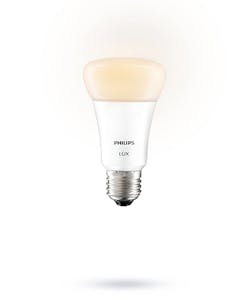Philips Lighting has announced a significant expansion of the Hue wireless-enabled LED lamp family at the Light+Building (L+B) trade fair. The new Hue Lux dimmable, white LED lamps will offer a lower cost alternative to the color-tunable products that Philips has previously introduced. Moreover, the company will deliver a new simplified tabletop control unit called Hue Tap.
The new products won't ship until the fall, but at that point will offer some relief from the one complaint we hear about the Hue system -- high prices. Individually, the color-tunable Hue lamps sell for $60 and a starter kit with a ZigBee bridge and three lamps goes for $200. The Hue Lux lamps will sell for $40 and a kit with a bridge and two lamps will be $100. The company has expanded the system and updated the control app regularly since introduction of the Hue family.
"Hue Lux is another entry point for people who are ready for the connected home," said Filip Jan Depauw, senior director at Philips Lighting. “Hue Lux offers personal wireless functional lighting, giving users perfect control over their homes by reinventing the dimmer switch, and giving you control via an array of apps. Hue Lux makes your everyday activity even brighter, with the ability to operate up to 50 bulbs with each smart bridge; once you have the kit, your connected lighting experience is completely scalable: you can add any Hue-compatible product to any room in your home."
Hue Tap
The Hue Tap, meanwhile, is interesting in that the $60 tabletop unit does not require power of any kind. The unit relies on technology called energy harvesting or scavenging. The kinetic energy created by a person depressing the switch allows a wireless module in the switch to awaken and transfer a command over the ZigBee wireless network utilized in Hue products.
Although Philips did not explicitly reveal the source of the energy harvesting technology, the switches in Hue Tap are apparently made by EnOcean Systems. The company has previously demonstrated the energy harvesting capability at lower-frequency wireless bands. At L+B the company demonstrated a switch working at the 2.4-GHz band used by ZigBee.
Philips did not say how a user will associate depresses on the Hue Tap buttons with specific actions in one or more lamps. That configuration will likely rely on a smartphone or PC to associate switches with lamps and switch depressions with actions. Once configured, however, an individual button could be used to turn a lamp on or off or to raise and lower the light level. The Hue Tap functionality does require the presence of a ZigBee bridge such as the one supplied in the Hue starter kits.
Decorative Hue
Philips did make one additional Hue-related announcement at L+B. The company introduced table and pendant Hue luminaires that are as much art as light. Indeed, the bigger news regarding the luminaires was that they were designed in conjunction with lighting design teams from WertelOberfell and Strand+Hvass and are being constructed using a 3-D printer. But the fixtures will carry a hefty EUR2500 to EUR3000 ($3400 to $4100) price tag.






